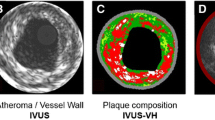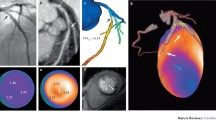Abstract
Cardiovascular disease is the leading cause of mortality and morbidity in developed countries. Evidence challenges the notion that the severity of lesions on angiography is a predictor of future cardiac events. With the recognition that subclinical coronary artery stenoses are responsible for myocardial infarcts and sudden death, it may be important to identify patients with plaque characteristics that may place them at increased risk. Intravascular ultrasound, though invasive, remains the current imaging gold standard. Computed tomography, cardiac magnetic resonance, and single-photon emission CT positron emission tomography are evolving and promising modalities. Functional studies reflecting plaque temperature and molecular imaging reflecting plaque constituents are being developed. We review the pathology of the vulnerable atherosclerotic plaque and recent innovations in imaging modalities to assess plaque complication risk.
Similar content being viewed by others
References and Recommended Reading
Muller JE, Tawakol A, Kathiresan S, Narula J: New opportunities for identification and reduction of coronary risk: treatment of vulnerable patients, arteries, and plaques. J Am Coll Cardiol 2006, 47:C2-C6.
Ambrose JA, Winters SL, Arora RR, et al.: Angiographic evolution of coronary artery morphology in unstable angina. J Am Coll Cardiol 1986, 7:472–478.
Little WC, Constantinescu M, Applegate RJ, et al.: Can coronary angiography predict the site of a subsequent myocardial infarction in patients with mild-to-moderate coronary artery disease? Circulation 1988, 78:1157–1166.
Lafont A: Basic aspects of plaque vulnerability. Heart 2003, 89:1262–1267.
Spagnoli LG, Bonanno E, Mauriello A, et al.: Multicentric inflammation in epicardial coronary arteries of patients dying of acute myocardial infarction. J Am Coll Cardiol 2002, 40:1579–1588.
Naghavi M, Libby P, Falk E, et al.: From vulnerable plaque to vulnerable patient - a call for new definitions and risk assessment strategies: Part II. Circulation 2003, 108:1772–1778.
Weissberg PL: Atherogenesis: current understanding of the causes of atheroma. Heart 2000, 83:247–252.
Toutouzas K, Vaina S, Tsiamis E, et al.: Detection of increased temperature of the culprit lesion after recent myocardial infarction: the favorable effect of statins. Am Heart J 2004, 148:783–788.
Stary HC, Blankenhorn DH, Chandler AB, et al.: A definition of the intima of human arteries and of its atherosclerosis- prone regions. A report from the Committee on Vascular Lesions of the Council on Arteriosclerosis, American Heart Association. Circulation 1992, 85:391- 405.
Falk E: Pathogenesis of atherosclerosis. J Am Coll Cardiol 2006, 47:C7-C12.
Dickson BC, Gotlieb AI: Towards understanding acute destabilization of vulnerable atherosclerotic plaques. Cardiovasc Pathol 2003, 12:237–248.
Stary HC: Natural history and histological classification of atherosclerotic lesions: an update. Arterioscler Thromb Vasc Biol 2000, 20:1177–1178.
Virmani R, Burke AP, Farb A, Kolodgie FD: Pathology of the Vulnerable Plaque. J Am Coll Cardiol 2006, 47:C13-C18. Excellent review of the pathology of the important vulnerable atheromatous plaques.
Farb A, Tang AL, Burke AP, et al.: Sudden coronary death. Frequency of active coronary lesions, inactive coronary lesions, and myocardial infarction. Circulation 1995, 92:1701–1709.
Virmani R, Kolodgie FD, Burke AP, et al.: Lessons from sudden coronary death: a comprehensive morphological classification scheme for atherosclerotic lesions. Arterioscler Thromb Vasc Biol 2000, 20:1262–1275.
Veinot JP, Srivatsa S, Carlson P: Beta3 integrin--a promiscuous integrin involved in vascular pathology. Can J Cardiol 1999, 15:762–770.
Abedin M, Tintut Y, Demer LL: Vascular calcification: mechanisms and clinical ramifications. Arterioscler Thromb Vasc Biol 2004, 24:1161–70.
Glagov S, Weisenberg E, Zarins CK, et al.: Compensatory enlargement of human atherosclerotic coronary arteries. N Engl J Med 1987, 316:1371–1375.
Fuster V, Stein B, Ambrose JA, et al.: Atherosclerotic plaque rupture and thrombosis: evolving concepts. Circulation 1990, 82:II–47-II-59.
Richardson PD, Davies MJ, Born GVR: Influence of plaque configuration and stress distribution on fissuring of coronary atherosclerotic plaques. Lancet 1989, 2:941–944.
Kullo IJ, Edwards WD, Schwartz RS: Vulnerable plaque: pathobiology and clinical implications. Ann Intern Med 1998, 129:1050–1060.
Ross R: Atherosclerosis--an inflammatory disease. N Engl J Med 1999, 340:115–126.
Torzewski J: C-Reactive protein and atherogenesis: new insights from established animal models. Am J Pathol 2005, 167:923–925.
Sun H, Koike T, Ichikawa T, et al.: C-reactive protein in atherosclerotic lesions: its origin and pathophysiological significance. Am J Pathol 2005, 167:1139–1148.
Khreiss T, Jozsef L, Potempa LA, Filep JG: Loss of pentameric symmetry in C-reactive protein induces interleukin-8 secretion through peroxynitrite signaling in human neutrophils. Circ Res 2005, 97:690–697.
Yeh ETH: A new perspective on the biology of C-reactive protein. Circ Res 2005, 97:609–611.
Burke AP, Farb A, Malcom GT, et al.: Coronary risk factors and plaque morphology in men with coronary disease who died suddenly. N Engl J Med 1997, 336:1276–1282.
Burke AP, Farb A, Malcom GT, et al.: Effect of risk factors on the mechanism of acute thrombosis and sudden coronary death in women. Circulation 1998, 97:2110–2116.
Nissen SE: Halting the progression of atherosclerosis with intensive lipid lowering: results from the Reversal of Atherosclerosis with Aggressive Lipid Lowering (REVERSAL) trial. Am J Med 2005, 118(Suppl 12A):22–27.
Nissen SE, Tuzcu EM, Schoenhagen P, et al.: Effect of intensive compared with moderate lipid-lowering therapy on progression of coronary atherosclerosis: a randomized controlled trial. JAMA 2004, 291:1071–1080.
Burgstahler C, Reimann A, Beck T, et al.: Imaging of a regressive coronary soft plaque under lipid lowering therapy by multi-slice computed tomography. Int J Cardiovasc Imaging 2006, 22:119–121.
Hartung D, Sarai M, Petrov A, et al.: Resolution of apoptosis in atherosclerotic plaque by dietary modification and statin therapy. J Nucl Med 2005, 46:2051–2056.
Agatston AS, Janowitz WR, Hildner FJ, et al.: Quantification of coronary artery calcium using ultrafast computed tomography. J Am Coll Cardiol 1990, 15:827–832.
Burke AP, Weber DK, Kolodgie FD, et al.: Pathophysiology of calcium deposition in coronary arteries. Herz 2001, 26:239–244.
Greenland P, LaBree L, Azen SP, et al.: Coronary artery calcium score combined with framingham score for risk prediction in asymptomatic individuals. JAMA 2004, 291:210–215.
Pletcher MJ, Tice JA, Pignone M, Browner WS: Using the coronary artery calcium score to predict coronary heart disease events: a systematic review and meta-analysis. Arch Intern Med2004, 164:1285–1292.
Van Mieghem CA, McFadden EP, de Feyter PJ, et al.: Noninvasive detection of subclinical coronary atherosclerosis coupled with assessment of changes in plaque characteristics using novel invasive imaging modalities: the Integrated Biomarker and Imaging Study (IBIS). J Am Coll Cardiol 2006, 47:1134–1142.
Shah PK: Mechanisms of plaque vulnerability and rupture. J Am Coll Cardiol 2003, 41:15S-22S.
Leber AW, Becker A, Knez A, et al.: Accuracy of 64-slice computed tomography to classify and quantify plaque volumes in the proximal coronary system: a comparative study using intravascular ultrasound. J Am Coll Cardiol 2006, 47:672–677.
Komatsu S, Hirayama A, Omori Y, et al.: Detection of coronary plaque by computed tomography with a novel plaque analysis system, ‘plaque map’, and comparison with intravascular ultrasound and angioscopy. Circ J 2005, 69:72–77.
Bengel FM: Atherosclerosis imaging on the molecular level. J Nucl Cardiol 2006, 13:111–118. Excellent overview of modern imaging modalities.
Carrio I, Pieri PL, Narula J, et al.: Noninvasive localization of human atherosclerotic lesions with indium 111-labeled monoclonal Z2D3 antibody specific for proliferating smooth muscle cells. J Nucl Cardiol 1998, 5:551–557.
Lees AM, Lees RS, Schoen FJ, et al.: Imaging human atherosclerosis with 99mTc-labeled low density lipoproteins. Arteriosclerosis 1988, 8:461–470.
Johnson LL, Schofield L, Donahay T, et al.: 99mTc-annexin V imaging for in vivo detection of atherosclerotic lesions porcine coronary arteries. J Nucl Med 2005, 46:1186–1193.
Dey D, Slomka P, Chien D, et al.: Direct quantitative in vivo comparison of calcified atherosclerotic plaque on vascular MRI and CT by multimodality image registration. J Magn Reson Imaging 2006, 23:345–354.
Yuan C, Mitsumori LM, Beach KW, Maravilla KR: Carotid atherosclerotic plaque: noninvasive MR characterization and identification of vulnerable lesions. Radiology 2001, 221:285–299.
Kampschulte A, Ferguson MS, Kerwin WS, et al.: Differentiation of intraplaque versus juxtaluminal hemorrhage/ thrombus in advanced human carotid atherosclerotic lesions by in vivo magnetic resonance imaging. Circulation 2004, 110:3239–3244.
Toussaint JF, Southern JF, Fuster V, Kantor HL: T2-weighted contrast for NMR characterization of human atherosclerosis. Arterioscler Thromb Vasc Biol 1995, 15:1533–1542.
Barkhausen J, Ebert W, Heyer C, et al.: Detection of atherosclerotic plaque with gadofluorine-enhanced magnetic resonance imaging. Circulation 2003, 108:605–609.
Sirol M, Itskovich VV, Mani V, et al.: Lipid-rich atherosclerotic plaques detected by gadofluorine-enhanced in vivo magnetic resonance imaging. Circulation 2004, 109:2890–2896.
Ruehm SG, Corot C, Vogt P, et al.: Magnetic resonance imaging of atherosclerotic plaque with ultrasmall superparamagnetic particles of iron oxide in hyperlipidemic rabbits. Circulation 2001, 103:415–422.
Kooi ME, Cappendijk VC, Cleutjens KB, et al.: Accumulation of ultrasmall superparamagnetic particles of iron oxide in human atherosclerotic plaques can be detected by in vivo magnetic resonance imaging. Circulation 2003, 107:2453–2458.
Author information
Authors and Affiliations
Corresponding author
Rights and permissions
About this article
Cite this article
Chow, B.J.W., Veinot, J.P. What are the most useful and trustworthy noninvasive anatomic markers of existing vascular disease?. Current Cardiology Reports 8, 439–445 (2006). https://doi.org/10.1007/s11886-006-0102-2
Issue Date:
DOI: https://doi.org/10.1007/s11886-006-0102-2




